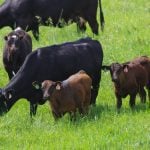Give people better beef and they will buy it.
This is the theory of MSA, or Meat Standards Australia, which has introduced a new grading system that guarantees good beef every time.
“We no longer want to grade beef based on the product we have to sell,” said Graham Truscott of the Angus Society of Australia.
Instead, extensive studies showed that better beef starts with the primary producer and follows up the chain to the retailer and the cook.
Most systems grade on color and yield, but the Australians wanted to go one step further and assess eating quality.
Read Also

More work wanted on removing red tape
REGINA — Canadian farmers risk falling further behind competitors if two main federal agencies don’t become more efficient and responsive…
Truscott explained the new system at the world Angus Secretariat meeting held recently in Calgary.
Hard to chew
Consumer surveys in Australia said 38 percent of beef had quality problems and more than half those polled complained of toughness of the meat.
By implementing controls over the way the animals are handled by farmers and the treatment of the carcass in the packing house, improvements were made.
One consumer taste test involved 180,000 people. They received samples of cooked beef derived from various breeds that came out of different feeding regimes.
The study showed people could differentiate beef quality using ratings such as everyday eating quality, superior and gourmet beef.
The first standards pilot in 1997 offering guaranteed quality to the retail level received an 80 percent consumer approval rating in Brisbane. This city was used as a test market because the beef quality there was generally known to be poorer.
To join the program, producers must agree to stress-free handling of animals. The beef must gain 600 grams, or 1.3 pounds, of weight per day, which indicates a controlled nutrition program throughout the animal’s life.
DNA swabs are taken of each carcass to trace any problems.
Maturity is measured in relation to the animal’s age, weight and appearance.
No more than 25 percent bos indicus (brahman type) breeding is allowed.
Ph levels must not be more than 5.7 and the beef must maintain a reasonable level after it is chilled.
In addition, some packers are hanging carcasses from the pelvis using the tender stretch technique rather than hanging them by the achilles tendon. This method appears to soften the middle cuts which are often ground up for hamburger or sausages.
Most recently, retailers have received MSA-branded beef packages with a label that identifies the cut, recommended cooking method and amount of aging the package has already received. An education program is ongoing to teach retail and food service people what these labels mean.
“It is a unique finding because it actually accurately predicts the way this product is going to eat,” said Truscott.

















